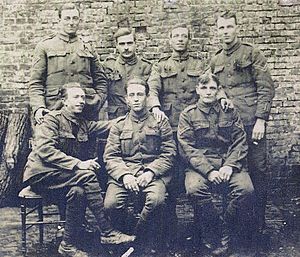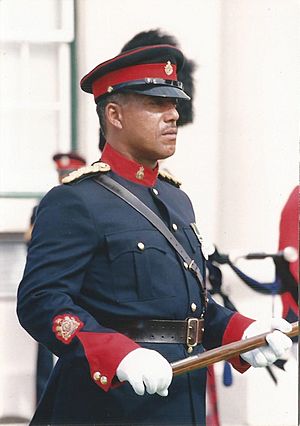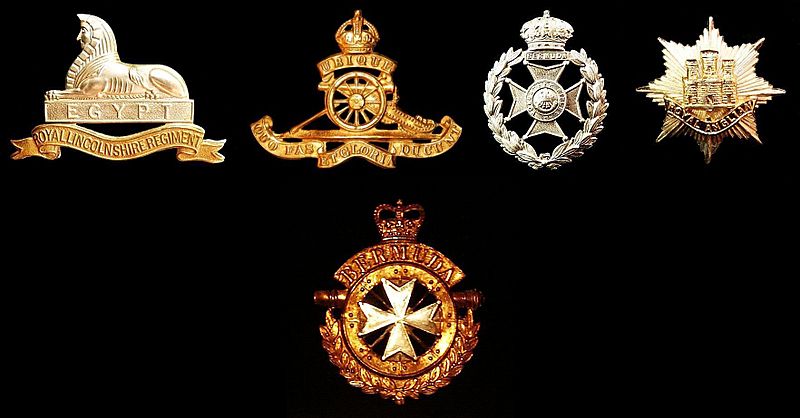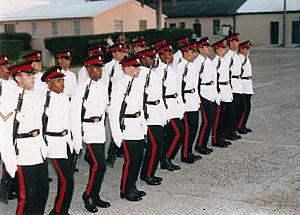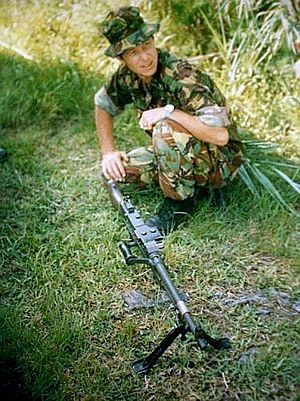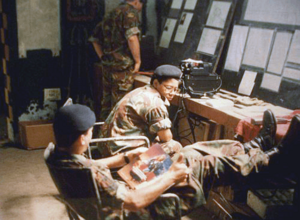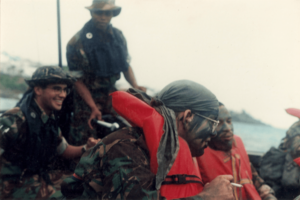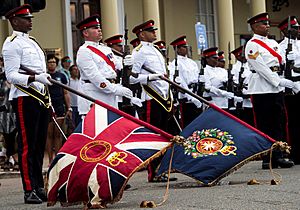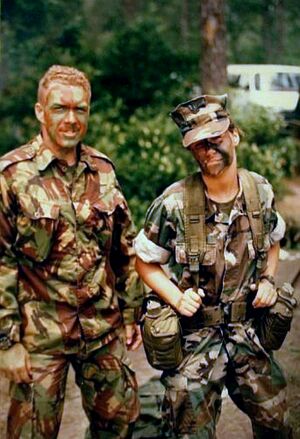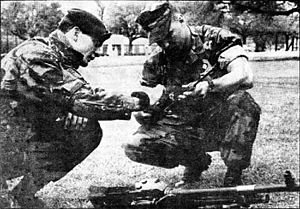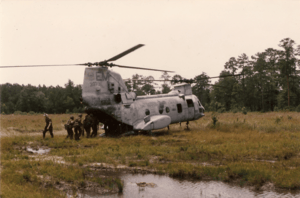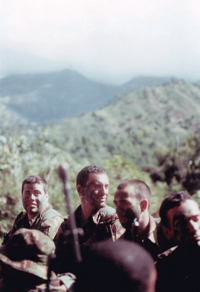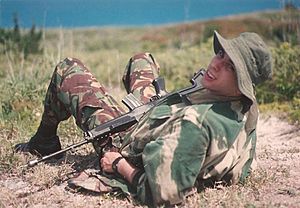Royal Bermuda Regiment facts for kids
Quick facts for kids Royal Bermuda Regiment |
|
|---|---|
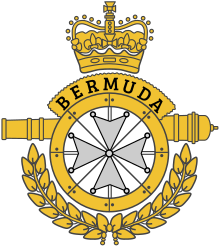
Cap Badge of the Royal Bermuda Regiment
|
|
| Active | 1 September 1965 |
| Country | |
| Branch | Army |
| Type | Line Infantry |
| Role | Internal security |
| Size | One Battalion ~350 reserve soldiers |
| Garrison/HQ | Warwick Camp |
| March | Quick – Bermuda |
| Anniversaries | 21 November 1965, presentation of the first colours. |
| Commanders | |
| Commanding Officer | Lt. Col. Benjamin Beasley, BEM |
| Colonel-in-Chief | The Duchess of Gloucester |
| Colonel of the Regiment |
Col. David Gibbons |
The Royal Bermuda Regiment (RBR) is Bermuda's local defence force. It used to be called the Bermuda Regiment. This group protects the British Overseas Territory of Bermuda. It is a single infantry battalion made up of part-time soldiers. The RBR was formed in 1965 when two older groups joined together. These were the Bermuda Militia Artillery (BMA) and the Bermuda Rifles. The RBR is the only military group left in Bermuda since 1957.
Contents
- What is the Royal Bermuda Regiment's History?
- What Does the Royal Bermuda Regiment's Badge Look Like?
- What Uniforms Does the Royal Bermuda Regiment Wear?
- What are the Ranks in the Royal Bermuda Regiment?
- How is the Royal Bermuda Regiment Organized?
- What Does the Royal Bermuda Regiment Do?
- How Does the Royal Bermuda Regiment Connect with Other Countries?
- Who are the Commanding Officers?
- What Equipment Does the Royal Bermuda Regiment Use?
- Gallery
- See also
- Order of precedence
What is the Royal Bermuda Regiment's History?
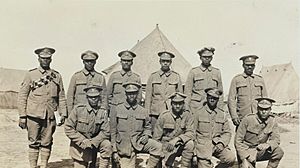
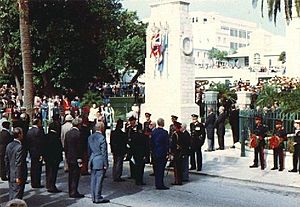
The two original groups, the Bermuda Militia Artillery (BMA) and the Bermuda Volunteer Rifle Corps (BVRC), were started in the 1890s. The British government wanted Bermuda to have its own local defence units. Soldiers from both groups went to France and Belgium in 1915. They fought in the First World War.
After the First World War, the British Army became smaller. This meant Bermuda's local units had more responsibility. In 1921, the BVRC was reorganized. Its soldiers agreed to serve for longer periods. The Bermuda Militia Artillery was also reorganized in 1928. Other units were created later, like the Bermuda Volunteer Engineers in 1931. The Bermuda Militia Infantry was formed in 1939 to help protect the island.
During the Second World War, some Bermudian soldiers went to Britain in 1940. They joined different British Army units. Later, more Bermudian volunteers fought in Europe and North Africa. A group from the Bermuda Volunteer Rifle Corps also fought in North West Europe and Burma.
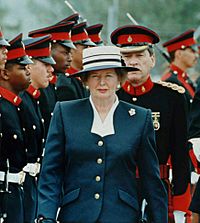
After the Second World War, the Bermuda Volunteer Rifle Corps was renamed the Bermuda Rifles. In 1965, the Bermuda Militia Artillery and the Bermuda Rifles joined together. This created the Bermuda Regiment. Princess Margaret presented the new regiment with its first special flags in November 1965. She presented a second set of flags in 1990. The most recent flags were presented by The Duchess of Gloucester in 2010.
On September 1, 2015, Queen Elizabeth II gave the regiment the title "Royal." This was to celebrate its 50th anniversary.
What Does the Royal Bermuda Regiment's Badge Look Like?
The badge of the Royal Bermuda Regiment combines parts from the badges of the older units.
The full badge, seen on the special flags, has two crossed cannons. Behind them is a Maltese cross. This cross is a symbol for rifle regiments in the British Army. The badge also has "THE BERMUDA REGIMENT" written around it. A wreath surrounds the whole design, with a Crown on top.
The cap badge, worn on hats, is made of two metals. It has a white metal Maltese cross inside a cannon wheel. This cannon wheel comes from the Royal Artillery badge. The colours used for the regiment are blue and red. These colours also come from the Royal Artillery. However, the special belt worn by staff and officers is rifle green with black edges. This colour comes from the BVRC.
What Uniforms Does the Royal Bermuda Regiment Wear?
The main dress uniform is dark blue, almost black. It has red cuffs and a red collar. The trousers have a wide red stripe down the side. A dark blue cap is worn with this uniform. In summer, a lighter white tunic is worn instead. This is called the No. 3 uniform. Because most public events are in summer, the No. 3 uniform is now worn all year. Only regimental drummers wear a special red tunic.
The combat uniform is now the British Army's Multi-Terrain Pattern design. This pattern helps soldiers blend into different environments. Bermuda's weather changes a lot. It can be cold and windy in winter, and hot and humid in summer. So, the regiment wears warmer uniforms in winter and lighter ones in summer.
For many years, the regiment wore a special parachute jacket called the Denison smock. Later, they started using the 1968 pattern DPM combat jacket. The beret they wear is dark blue, like the one worn by the Royal Artillery.
A formal "Service Dress" uniform is only given to a few full-time staff members. It is a greenish-khaki colour. For special events, officers wear a "Mess dress" uniform.
What are the Ranks in the Royal Bermuda Regiment?
| Rank group | General/flag officers | Senior officers | Junior officers | Officer cadet | ||||||||||||||||||||||||||||||||||
|---|---|---|---|---|---|---|---|---|---|---|---|---|---|---|---|---|---|---|---|---|---|---|---|---|---|---|---|---|---|---|---|---|---|---|---|---|---|---|
 |
 |
 |
 |
 |
 |
|||||||||||||||||||||||||||||||||
| Lieutenant colonel | Major | Captain | Lieutenant | Second lieutenant | Officer cadet | |||||||||||||||||||||||||||||||||
| Rank group | Senior NCOs | Junior NCOs | Enlisted | |||||||||||||||||||||||||||||||||
|---|---|---|---|---|---|---|---|---|---|---|---|---|---|---|---|---|---|---|---|---|---|---|---|---|---|---|---|---|---|---|---|---|---|---|---|---|
 |
 |
 |
 |
No insignia
|
||||||||||||||||||||||||||||||||
| Warrant officer class 1 | Warrant officer class 2 | Colour Sergeant | Sergeant | Corporal | Lance corporal | Private | ||||||||||||||||||||||||||||||
How is the Royal Bermuda Regiment Organized?
Who Leads the Regiment?
Bermuda is a British territory, so the Governor is in charge of the Royal Bermuda Regiment. The Governor is also the Commander-in-Chief. The regiment's funding comes from Bermuda's government. The RBR is ranked 29th in the British Army's official list of units.
The Duchess of Gloucester is the regiment's Colonel-in-Chief. A lieutenant-colonel directly commands the unit. This leader is chosen by the Governor.
How Many Soldiers are in the Regiment?
The regiment started with about 400 soldiers. After some challenges, it was suggested to increase the size to about 750 soldiers. This would allow for three rifle companies and a support company. Today, the regiment has about 350 soldiers. They train for about 30 days each year.
What is the Regiment's Structure?
New recruits now train for three months after their initial two-week training. Then they join one of the companies. The current structure includes:
- Regimental Headquarters
- A Company (focuses on support units, boat troop, and police)
- B Company (focuses on helping after disasters and ceremonial duties)
- Logistics Company
- Training Wing
- Coast Guard
The Royal Bermuda Regiment is mainly an infantry unit. This means its soldiers fight on foot. However, it has a ceremonial "Gun Troop" with two large field guns. This troop remembers the regiment's history as an artillery unit.
What About Conscription?
For many years, most of the regiment's soldiers were conscripts. This meant men aged 18 to 23 were chosen by a lottery to serve. Some people criticized this system. However, it was also praised for bringing different social and racial groups together.
In 2018, Bermuda's government voted to end conscription. Now, all soldiers in the Royal Bermuda Regiment are volunteers.
What is the Junior Leaders Program?
The Royal Bermuda Regiment used to have its own "Junior Leaders" program. This program helped young people learn about military life. In 2012, this program was brought back. Many of the regiment's officers and leaders started their service in the Junior Leaders. In 2015, a law was proposed to make the Junior Leaders program official.
What Does the Royal Bermuda Regiment Do?
The main job of the regiment is now disaster relief. They also perform ceremonial duties, like parades. They help the Bermuda police with security issues, including riot control and anti-terrorism. After the September 11 attacks in 2001, the regiment helped secure Bermuda's airport. In 2004 and 2005, they helped the Cayman Islands and Grenada after hurricanes.
In 2007, a group of soldiers went to Barbados. They helped with security for the Cricket World Cup. They worked with soldiers from other countries. This was the first time since World War I that a Bermudian unit deployed overseas for a non-disaster mission.
The regiment also helps the community in many ways. They are part of many cultural events on the island, especially parades.
How Does the Royal Bermuda Regiment Connect with Other Countries?
During the First World War, the BVRC worked with the Lincolnshire Regiment from the UK. This connection became official after the war. The Lincolnshire Regiment helped the BVRC with training and officers.
During the Second World War, the BVRC again sent soldiers to serve with the Lincolns. When the Bermuda Regiment was formed, the Royal Anglian Regiment (which the Lincolns had joined) continued this partnership. The Royal Anglians often send officers and instructors to help the Royal Bermuda Regiment.
The Royal Bermuda Regiment also has a good relationship with the United States Marine Corps (USMC). The regiment often trains at USMC bases in North Carolina. This training helps them learn new skills. For example, their boat troop trains with the United States Coast Guard.
They also have connections with the Royal Gibraltar Regiment. In 2007, the regiment held its annual training camp in England for the first time.
The Royal Bermuda Regiment is now helping to train new recruits for the Cayman Regiment. The first group of Caymanian recruits joined Bermudian recruits for training in 2020.
Who are the Commanding Officers?
The commanding officer of the Royal Bermuda Regiment is a full-time job. The person in this role usually serves for three years. The commanding officer is usually a major from the regiment who is promoted to lieutenant-colonel. In 2013, Lieutenant-Colonel Michael Foster-Brown became the first non-Bermudian to lead the regiment. He was followed by Lieutenant-Colonel David Curley in 2016, and then Lieutenant-Colonel Benjamin Beasley in 2020.
What Equipment Does the Royal Bermuda Regiment Use?
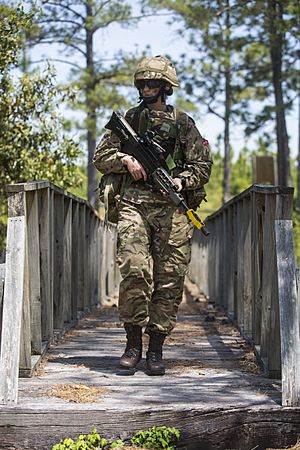
The regiment uses modern weapons and vehicles. In 1983, they started using the American-made Ruger Mini-14 rifle. They also use the General Purpose Machine Gun (GPMG). For riot control, they use the ARWEN 37 weapon.
In 2015, the Ruger Mini-14 was replaced by the L85A2 version of the SA80 rifle. This is the standard rifle used by the British Army.
Rifles and Shotguns
 L85A2 SA-80 rifle (standard issue since 2016)
L85A2 SA-80 rifle (standard issue since 2016) Mini-14GB/20 rifle (used from 1983 to 2016)
Mini-14GB/20 rifle (used from 1983 to 2016) L1A1 Self-Loading Rifle (used from 1965 to 1983)
L1A1 Self-Loading Rifle (used from 1965 to 1983) Heckler & Koch G36 (used by specialist units)
Heckler & Koch G36 (used by specialist units) Colt M4 (used for trials)
Colt M4 (used for trials) L42A1 sniper-rifle
L42A1 sniper-rifle Mossberg 500 shotgun
Mossberg 500 shotgun
Pistols and Submachine Guns
 Beretta 92 semi-automatic pistol
Beretta 92 semi-automatic pistol Glock 17 semi-automatic pistol
Glock 17 semi-automatic pistol
Machine Guns
Internal Security (IS) Equipment
Artillery
Vehicles
 Toyota Land Cruiser J70
Toyota Land Cruiser J70 Mitsubishi L 300 van
Mitsubishi L 300 van Ford 350 Ambulance
Ford 350 Ambulance UD 2300DH truck
UD 2300DH truck Toyota Dyna truck
Toyota Dyna truck Toyota HiAce van
Toyota HiAce van Toyota LiteAce Minivan
Toyota LiteAce Minivan
Boats
Radio
Gallery
-
A Permanent Staff Instructor (PSI) with senior Non-Commissioned Officers of the Bermuda Regiment.
-
The main gate of Warwick Camp.
-
A motorboat of the Bermuda Regiment Boat Troop near the HMD, Bermuda.
-
An NCO from The Lincoln and Welland Regiment training with the Bermuda Regiment in Jamaica in 1996.
-
Jamaica Defence Force soldier with a sergeant of the Bermuda Regiment in the Blue Mountains of Jamaica.
-
An NCO of the Bermuda Regiment with a General Purpose Machine Gun on a Rigid Raider boat.
-
A Bermuda Regiment NCO in No. 5 (Desert Combat) Dress with a Galil AR self-loading rifle at USMC Camp Lejeune in 1994.
See also
- Cayman Islands Regiment
- Turks and Caicos Islands Regiment
- Royal Gibraltar Regiment
- Falkland Islands Defence Force
- Royal Montserrat Defence Force
- British Army Training and Support Unit Belize
- Overseas military bases of the United Kingdom
Order of precedence
| Preceded by Royal Gibraltar Regiment |
Order of Precedence | Succeeded by |


